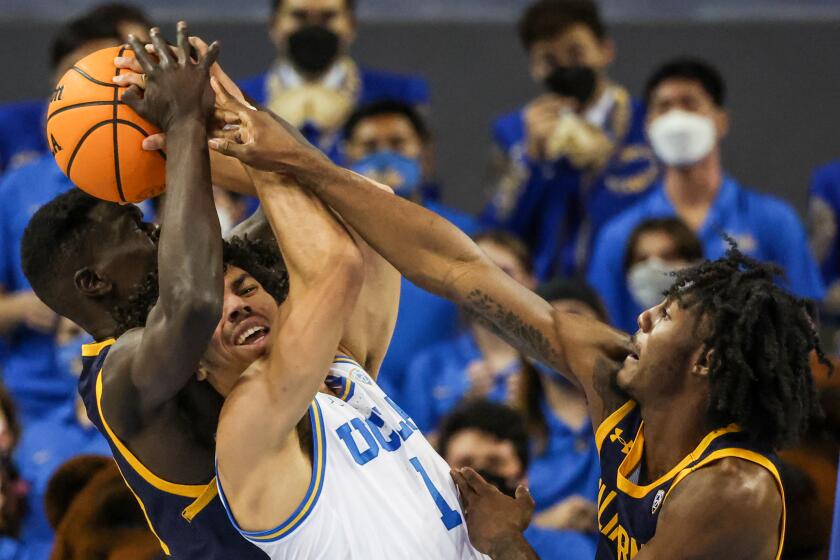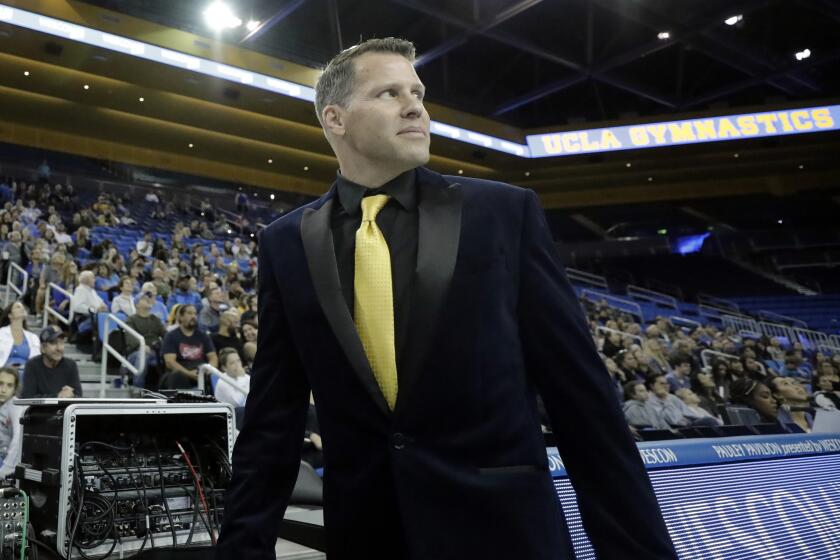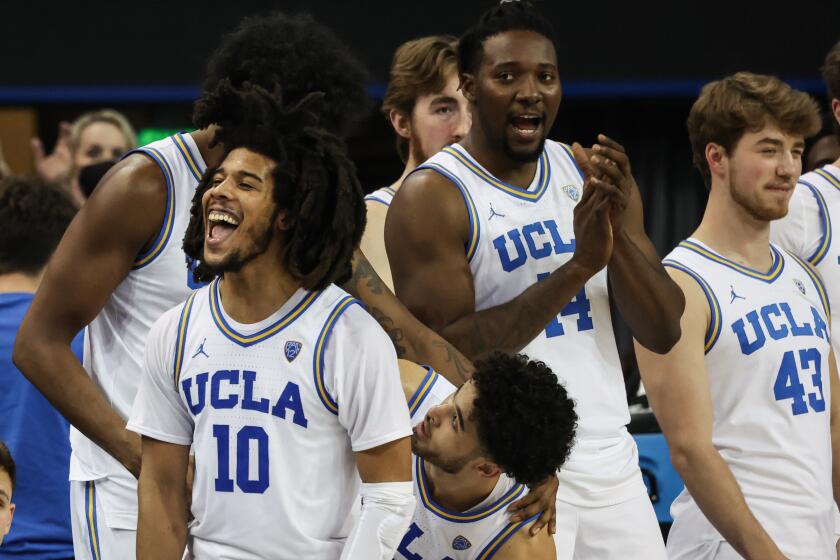Slammed by double whammy, UCLA posts record $62.5 million in athletic department debt
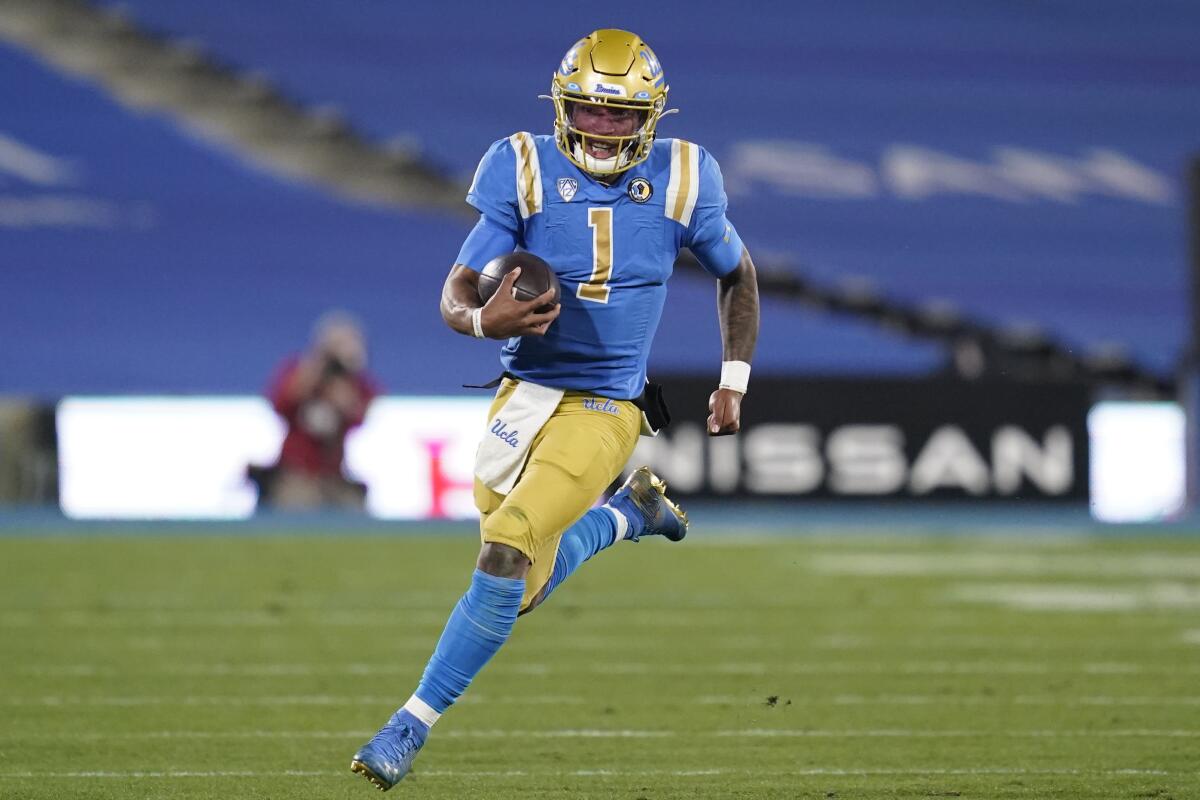
- Share via
No fans plus fewer games has added up to big trouble for UCLA’s already grim athletic department finances.
The Bruins’ record $62.5-million deficit for the 2021 fiscal year, according to an unaudited statement of revenues and expenses obtained by The Times, reflected the many ways in which COVID-19 has bushwhacked schools from coast to coast.
“The impact of the pandemic continues to be felt at collegiate athletic departments across the nation,” UCLA athletic department spokesman Scott Markley said in a statement.
The shortfall also revealed several unique challenges that have saddled UCLA with a three-year deficit of $102.8 million, a staggering figure for a department that had not previously operated in the red since posting a negligible deficit in 2004.
Jaime Jaquez Jr. finished with 15 points as No. 7 UCLA defeated California 81-57 to take sole possession of first place in the Pac-12 standings.
The Bruins receive just a pittance from campus sources compared with other athletic departments; they do not pocket stadium sponsorship sales and recoup just a small percentage of sales from parking, concessions, merchandise and premium seating sales at the Rose Bowl; they pay a usage fee for games at Pauley Pavilion while receiving only a sliver of concession and merchandise sales; they receive no parking revenue at any venue while footing the bill for staffing; and they refused to enact furloughs or staffing cuts during the pandemic, a rarity at a time when other departments liberally slashed salaries and jobs.
Those issues were exacerbated by UCLA’s inability to host fans during the fiscal year that ended June 30, 2021, losing millions of dollars in ticket revenue. During the 2020 fiscal year, the school generated $14.7 million in ticket sales across all sports, a number that dropped to zero one year later with fans barred from the Rose Bowl and Pauley Pavilion.
Playing only seven football games in 2020 led to a 22.2% decrease in media-rights revenue from the previous fiscal year, the Bruins pulling in $14.47 million for the 2021 fiscal year. Media-rights revenue was down a nearly identical 22.3% for men’s basketball, to $2.55 million, after the Bruins played six fewer games in the regular season than they had the previous year.
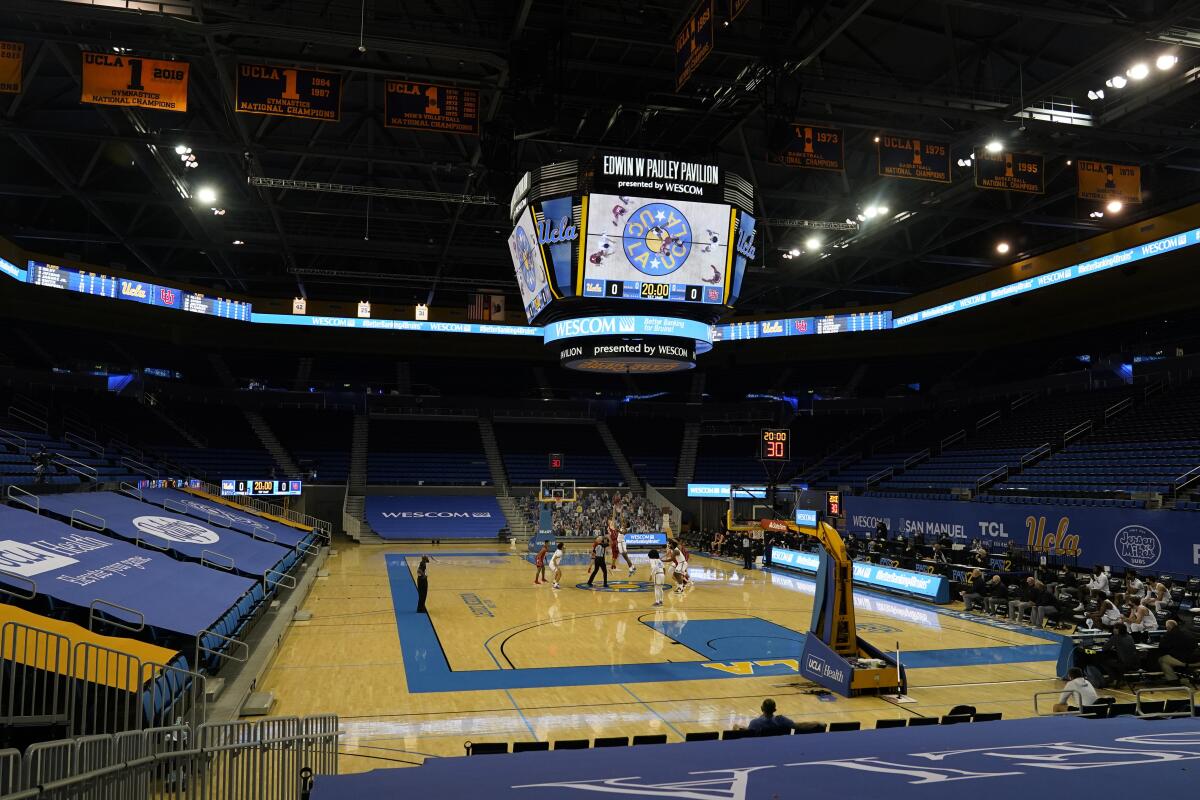
Under Armour’s termination of its record $280-million apparel deal with UCLA that provided the school roughly $11 million per year in rights and marketing fees was largely responsible for a 66.7% drop in royalties, licensing, advertisement and sponsorship revenue, which dropped from $24.19 million to $8.06 million.
The school’s replacement deal with Nike and Jordan Brand generates just $500,000 per year in cash compensation in addition to a product allotment that fluctuates from $6.5 million to $9.5 million over the six-year contract. (UCLA also may elect to adjust its compensation to receive a small cash increase in exchange for a reduction in gear.)
Chris Waller looked poised to continue UCLA gymnastics’ legacy of success when he became head coach in 2019. It hasn’t all gone according to plan.
There were also pandemic-related costs, including about $2 million for coronavirus testing and another $1 million for shared testing costs among Pac-12 Conference schools.
The Bruins also continue to be dragged down by debt service on a cluster of new or renovated athletics facilities. In the 2021 fiscal year, the athletic department paid $9.04 million to service the debt on expansion and renovation of Pauley Pavilion and the Morgan Center in addition to the recently constructed Wasserman Football Center and Mo Ostin Center.
Given the size of UCLA’s deficit, creative solutions are welcome.
“We’ve looked at our budget both from a revenue-generation standpoint as well as operational expenses and are developing solutions along with [the] campus,” Markley said. “We have begun to enact many measures already, including with cost reductions and increased revenues from ticket packages and pricing” as fans returned to games last fall.
Additional savings have been achieved by limiting travel to away games out of conference to consolidate travel costs, among other measures. Football meals that cost $5.4 million as recently as the 2019 fiscal year have been slashed to $2.15 million thanks to efficiencies in pricing and quantity.
The intensity demanded by third-year UCLA coach Mick Cronin has become part of the Bruins’ very nature. The result could be a national championship.
Ultimately, the biggest savior could be the university itself. As in recent years, UCLA is covering its athletic department’s debt with a loan that must be repaid in full. But university officials could do more to keep the Bruins on equal footing with conference counterparts that have more highly prioritized their sports programs.
California, constantly jockeying with UCLA for the distinction of being known as the nation’s top state school, cut a $20.1-million check for athletics in the 2021 fiscal year as part of chancellor Carol Christ’s commitment to sports programs, according to a report in the San Jose Mercury News.
Contrast that with UCLA’s athletic department, which receives just $60,000 a year in direct institutional support in addition to about $2.5 million in student fees, a total that’s roughly half of the $5.2-million average among the Pac-12’s other public schools. (As private schools, USC and Stanford are not required to disclose their financial information.)
The Golden Bears also benefited from an anonymous $19-million donation, the Mercury News reported, nudging an athletic department that otherwise would have landed deep in the red into a $3.5-million surplus.
It was a Hail Mary for the bottom line. When all else fails, a fat check always helps.
More to Read
Go beyond the scoreboard
Get the latest on L.A.'s teams in the daily Sports Report newsletter.
You may occasionally receive promotional content from the Los Angeles Times.

